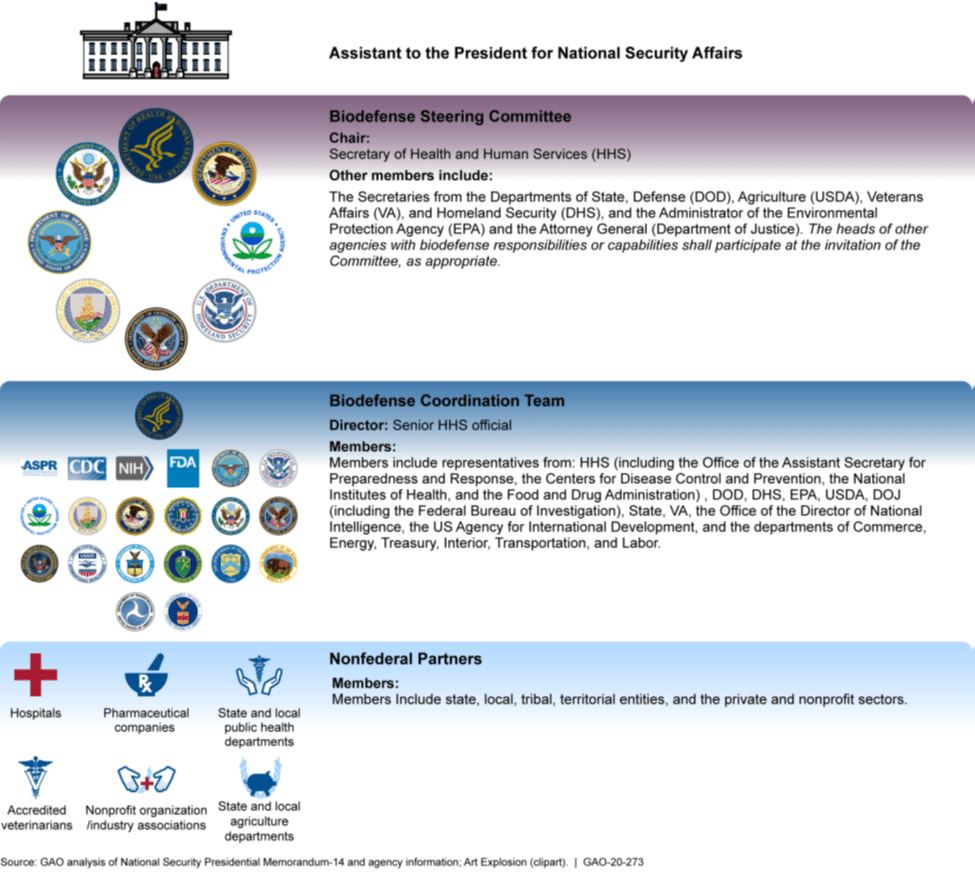Has Colossal Systemic Preparedness Failure Caused the Death of Tens of Thousands of Americans?
The high death rate in the United States, from COVID-19 is reality-based evidence demonstrating the colossal failure of the multi-layered system of uncoordinated agencies to ensure national preparedness to meet the people’s essential needs
Given the enormous per capita U.S. expenditure for healthcare and pandemic public health preparedness – $3.6 trillion in 2018 – or $11,172 per person[1]– it is astonishing that the escalating expenditure has not improved people’s health.[2] Furthermore, when confronted with a virus pandemic about which officials were forewarned,[3] systemic failures were exposed. The astronomical expenditure has vastly increased profit margins of the healthcare industry; including pharmaceutical corporations, health insurance providers,[4] and highly profitable, so-called non-profit hospitals.[5]

The consequences are borne by those on the front line:
“Doctors have been instructed not to enter patients’ rooms unless they must as a way to minimize their exposure to the virus that causes Covid-19 while nurses go from one room to the next, medicating, bathing, turning, and comforting their patients without changing their uncomfortable personal protective equipment, since supplies are limited. This work can take hours. It is not uncommon for nurses to go all day without drinking water or eating because that would mean removing our protective gear.” I’m A Nurse In A Covid-19 Unit. My Hospital’s Leaders Frighten Me More Than The Virus
Since 9/11, the government focused on terrorism and neglected pandemics. Tens of billions of dollars have been allocated for biodefense emergency preparedness. A thriving industry and an expansive government bureaucracy has spawned high containment laboratories and minted thousands of scientists who work within the biodefense milieu – without proper oversight.. A 2007 analysis found that the expenditure by the Centers for Disease Control (CDC) for “terrorism preparedness had increased 10-fold, whereas its budget for core functions, such as tracking infectious diseases had dropped.
Unheeded Signals and Warnings
In 2012, the Rand Corporation’s Center for Global Risk and Security published a report[6] assessing the international threats confronting the United States: nuclear proliferation, confliect in the greater Middle East, water scarcity, pandemics and climate change. The authors concluded that only pandemics posed an existential danger because they were “capable of destroying America’s way of life.”
In 2015, Bill Gates warned that “a pandemic disease is the most predictable catastrophe in the history of the human race, if only because it has happened to the human race so many, many times before.” The algorithm he relies on is the faulty model designed by *Ferguson of the Imperial College of London. That algorithm had repeatedly arrived at the preposterous predictions of deaths. But Bill Gates has an agenda which includes fomenting panic about infectious diseases in order to promote the universal use of vaccines from which he, his wife, and Warren Buffet – the trustees of the Bill and Melinda Gates Foundation – profit.[7]
In 2017, a week before the inauguration of President Donald Trump, the outgoing homeland-security adviser, Lisa Monaco, met with the incoming national-security officials and conducted an exercise modeled on the Obama administration’s experiences with outbreaks of swine flu, Ebola, and Zika. The simulation explored how the U.S. government should respond to a flu or other pandemic respiratory disease.
Systemic Disarray
Homeland Security Today reports that responsibility for biodefense is currently divvied up between 15 federal agencies, eight independent agencies (including the CIA and U.S. Postal Service), and one independent institution: the Smithsonian.
This is how the website (Public Health Emergency) describes the mission and responsibilities of ASPR (Assistant Secretary of Preparedness Response) which received $2.6 billion in FY 2020:
- ASPR’s mission is to save lives and protect Americans from 21st century health security threats. ASPR leads the nation in preventing, preparing for, responding to, and recovering from the health effects of disasters and public health emergencies.
- ASPR focuses on preparedness planning, response, and recovery; building emergency operational capabilities; medical countermeasures (MCM) research and advanced development; and, providing resources to support health care systems, hospitals, and providers.
- ASPR coordinates across HHS and the federal government to support state, local, territorial, and tribal partners in preparing for, responding to, and recovering from public health emergencies and disasters.
- ASPR enhances medical surge capacity by organizing, training, equipping, and deploying federal public health and medical personnel while providing logistical support for federal responses during public health emergencies.
But, as was repeatedly documented by independent panels, the coordinated actions required in order “to save lives and protect Americans” were not, in fact, carried out.
In 2015, the Blue Ribbon Study Panel on Biodefense issued “A National Blueprint for Biodefense Leadership and Major Reform Needed to Optimize Efforts. In its opening Preface it states:
“The United States is underprepared for biological threats. Nation states and unaffiliated terrorists (via biological terrorism) and nature itself (via emerging and reemerging infectious diseases) threaten us…Despite significant progress on several fronts, the Nation is dangerously vulnerable to a biological event. The root cause of this continuing vulnerability is the lack of strong centralized leadership at the highest level of government.”
“serious gaps and inadequacies that continue to leave the Nation vulnerable to threats fro nature and terrorists alike. Successive Presidents, beginning with William J. Clinton and followed by George W. Bush and Barack H. Obama, enacted policies intended to strengthen national biodefense.
Yet fourteen years after the last report of the U.S. Commission on National Security/21st Century… [perfectpullquote align=”right” bordertop=”false” cite=”” link=”” color=”” class=”” size=””]the insufficiency of our myriad and fragmented biodefense activities persists because biodefense lacks focused leadership[/perfectpullquote]
… no steward guides them collectively.”
The report recommended that lawmakers “mandate the development of an integrated budget that allows Congress and the administration to understand how the government funds the entire biodefense enterprise.”
The Panel recommended creation of a Biodefense Coordination Council with the vice president at the political helm.
In February 2018, the Blue Ribbon Panel report again noted:
“The process by which the government funds federal biodefense-related programs and activities precludes strategic allocation of dollars. The current system does not enable decision makers to evaluate the return on investment in existing programs, identify mission-critical gaps, or prioritize funding across requirements.”
The report cited budget allocations that are misaligned with the threat; such as hospital preparedness. Hospitals “receive [] pennies per person despite gaping needs.” By contrast, [perfectpullquote align=”right” bordertop=”false” cite=”” link=”” color=”” class=”” size=””]“programs of questionable worth get more funding in a murky federal interagency structure on biodefense.[/perfectpullquote]
”
“The financial impact of major biological events is staggering. The direct and indirect economic costs of outbreaks and the response to them now regularly extend into the billions. The costs are so high (and unaccounted for in annual budgets) that supplemental requests and appropriations have become the norm to deal with them (e.g., $7.7 billion in 2009 for H1N1, $5.4 billion in 2014 for Ebola, $1.1 billion in 2016 for Zika)
On May 7, 2018, Luciana Borio, then the director for medical and biodefense preparedness at the National Security Council (NSC), told attendees at a symposium convened by the CDC, that “the threat of pandemic flu is our number-one health security concern.” The following day John Bolton, then National Security Adviser, eliminated the NSC.
In December 2019, Congress authorized a spending package that provided increases for key U.S. Public Health and Social Services Emergency Fund. Overall the Department of Health and Human Services (HHS) was allocated $94.9 billion, an increase of $4.4 billion above 2019. Of that allocation, the Centers for Disease Control (CDC) received $8 billion, a $636 million increase over 2019. [perfectpullquote align=”full” bordertop=”false” cite=”” link=”” color=”” class=”” size=””] The $8 billion allocation to the CDC mandates CDC to “to maintain a strong and central role in the medical countermeasures enterprise.” [/perfectpullquote]
As reported in Homeland Preparedness News: the Public Health and Social Services Emergency Fund, within the CDC budget, prepares for “all public health emergencies” including bioterrorism and federal efforts against infectious diseases; it was allocated $2.74 billion to “support a comprehensive program to prepare for and respond to the health and medical consequences of all public health emergencies, including bioterrorism, and support the cybersecurity efforts of HHS.”
These funds were to protect against infectious diseases, pandemic influenza and antimicrobial resistance including ensuring that the Strategic National Stockpile (SNS). The spending package allocated $535 million for vaccines, medicines and diagnostic tools to be purchased for the SNS.
- Increased funds for the SNS were supposed to strengthen U.S. national security, as well as public health and disaster preparedness, ensuring that the right medicines and supplies remain available for public health threats and emergencies.
As the COVID-19 pandemic demonstrates, the Strategic National Stockpile. was utterly unprepared; it lacked an adequate supply of essential emergency equipment. As Michael Schulson in SALON writes:
“The bungled response to the COVID-19 pandemic — including a failure to produce enough tests for the virus, shortages of critical medical supplies, understaffing at local health departments, and sluggish federal action overall — has highlighted, once again, profound vulnerabilities in the country’s public health system…[perfectpullquote align=”right” bordertop=”false” cite=”” link=”” color=”” class=”” size=””]some policy experts are now wondering what happened to all that post-9/11 public health infrastructure funding[/perfectpullquote]
, and why those investments are not helping the country now…
it offers a stark warning on how political inattention, questionable spending choices, and shifting policy priorities still left the U.S. public health system unprepared for a pandemic — a threat that many experts knew was almost certain to arrive.”
-
How did CDC officials allocate the National Stockpile funds that were intended for drugs, vaccines and personal protective equipment (PPE)?
In February 2020, the General Accounting Report to Congress[8] re-iterated its prior warning about the danger posed to national security and public health. “Since March 2011, we have reported that the biodefense enterprise would benefit from institutionalized leadership with sufficient time, responsibility, authority, and resources needed to promote efficiency and accountability.”
The GAO report underscored danger posed by the current jumble of agencies that lack structure, lack of leadership, chain of command, and long-standing failure to develop a coordinated strategy and enforcement process.
“the inherent fragmented nature of the biodefense enterprise and long-standing challenges to building and maintaining the nation’s biological defense capabilities that transcend what any one federal department or agency can address on its own…
Catastrophic biological threats highlight the inextricable link between security and public health concerns. These threats—whether naturally occurring, intentional, or accidental—have the potential to cause loss of life and sustained damage to the economy, societal stability, and global security.”
The GAO stressed that [perfectpullquote align=”right” bordertop=”false” cite=”” link=”” color=”” class=”” size=””]”Cultivating a strong biological defense requires an understanding of a multitude of biological threats. The nature of these threats can be intentional, naturally occurring, or accidental…”[/perfectpullquote]
The GAO raised the danger posed by laboratories around the world that are tinkering with dangerous pathogens:
“Finally, in many countries around the world, pathogens are stored in laboratories that lack appropriate biosecurity measures where they could be diverted by actors who wish to do harm. Advances in science and technology bring revolutionary cures and progress, but they also have the potential to facilitate intentional misuse. As we reported in 2016, some laboratories do not have appropriate biocontainment or biosafety protocols. These shortfalls could lead to outbreaks through laboratory acquired infections or pathogens accidently being released into the environment.14
State and Federal government and public health officials have been entrusted by the people to ensure that – at the very least – the public is protected in the event of a life-threatening emergency. These officials – some of who have held high office for more than three decades – knew from simulated exercises such as Crimson Contagion 2019 – whose alarming revelations laid bare the abysmal fractured US healthcare infrastructure. What’s more these officials – whom the media anoints as “experts” – concealed the revelations of those simulations, and proceeded to do NOTHING.
Miscalculation at Every Level Left U.S. Unequipped to Fight Coronavirus (April 29, 2020)
A report by a team of investigative reporters for The Wall Street Journal describes in detail how the federal government and the nation’s hospitals failed the American people. They failed to prepare for a pandemic to safeguard the nation, – even after the 2009 H1N1 Swine flu outbreak, which signaled that a major pandemic would occur.
“But neither hospitals nor manufacturers nor the government made sweeping changes to be ready for one. Instead, each part of the medical-industrial equation acted in its own interest, and didn’t set aside resources that might have better prepared America for the coronavirus crisis. Each ignored warnings of shortages of protective equipment in case of a pandemic—shortages that handicapped the struggle against the virus early on and continue today.
—The hospital industry, in a bid to increase profit, slashed inventory of all supplies. Rather than bulk up after the swine flu, hospitals turned to inventory-tracking software to winnow stocks of protective gear and other supplies, hoping to be able to replenish it as needed.
On February 10, , a Trump administration budget for next fiscal year proposed cutting money for the Federal Emergency Management Agency’s disaster-relief fund by nearly 70%…In March Congress approved $45 Billion more for FEMA.
States, hospitals and health-care professionals soon began saying they were in dire need of basic personal protective gear, weren’t getting their full orders filled, and weren’t getting what they believed they should from the federal stockpile. Officials at HHS’s emergency-planning agency told congressional staffers on Feb. 14 there could be a shortfall of billions of respirator masks if the virus spread across the U.S.
Eleven days later, HHS Secretary Alex Azar told a Senate hearing the U.S. had 30 million N95 masks but would need 270 million more.
The next day, Mr. Azar said he had misspoken. He said there were 30 million of the more-basic surgical masks in the national stockpile but just 12 million N95 masks, five million of which were past expiration dates.
Maintaining the nation’s preparedness is the responsibility of government officials and the public health sector. The collective failure of our government bureaucracy and a profit-focused public healthcare industry, to carry out their public responsibility — despite having specific funding allocations to pay for such protection – is the cause of our current deadly nightmare.
Their failure is demonstrated by sub-standard, inadequate stockpiles that lacked basic, vital medical provisions – such as masks and personal protective equipment and medicines to meet the need of the citizenry. Surely a Department of Justice investigation is in order.

Dr. Andy Xie, a Shanghai based independent economist who writes and consults on global economics and financial markets[9] put it succinctly in an Opinion piece in the South China Morning Star, he stated: “The global ruling elite, who ignored expert warnings of a pandemic, are even now proposing stimulus measures to prop up markets, rather than truly help people.”
References:
[1] National Health Expenditure Accounts. Centers for Medicare & Medicaid Services, 2018
[2] US Life expectancy and infant mortality rate compares poorly with the rest of the world. See: Organization for Economic Cooperation and Development (OECD) data.
[3] We Were Warned :When the inevitable inquiry into the government’s response to COVID-19 happens, it will conclude that signs of a coming crisis were everywhere. Uri Friedman, The Atlantic, MARCH 18, 2020
[4] Health Insurer Profits Soar, Bruce Japsen, Forbes, August 2019
[5] Top US “Non-Profit” Hospitals & CEOs Are Racking Up Huge Profits, Adam Andrzejewski, June 2019
[6] Threats Without Threateners? Exploring Intersections of Threats to the Global Commons and National Security, Gregory Treverton, Erik Nemth, Siduja Srinivason, Rand Corporation, 2012
[7] As documented by Tim Schwab in The Nation, March 17, 2020. Read also, Coronavirus Provides Dictators & Oligarchs with a Dream Come True, March 26, 2020
[8] National Biodefense Strategy Additional Efforts Would Enhance Likelihood of Effective Implementation. General Accounting Office, February 2020
[9] How the Greedy Ruling Elite Failed Us, by Putting Profit Before Pandemic Preparedness by Dr. Andy Xie, Opinion, South China Morning Post, April 6, 2020
Dr Xie is a Shanghai based independent economist specializing in China and Asia. He joined Morgan Stanley in 1997 and was managing director and head of the firm’s Asia-Pacific economics team until 2006. He also spent five years as an economist with the World Bank. He was voted one of the 50 most influential persons in finance by Bloomberg magazine in 2013. His Opinion piece







